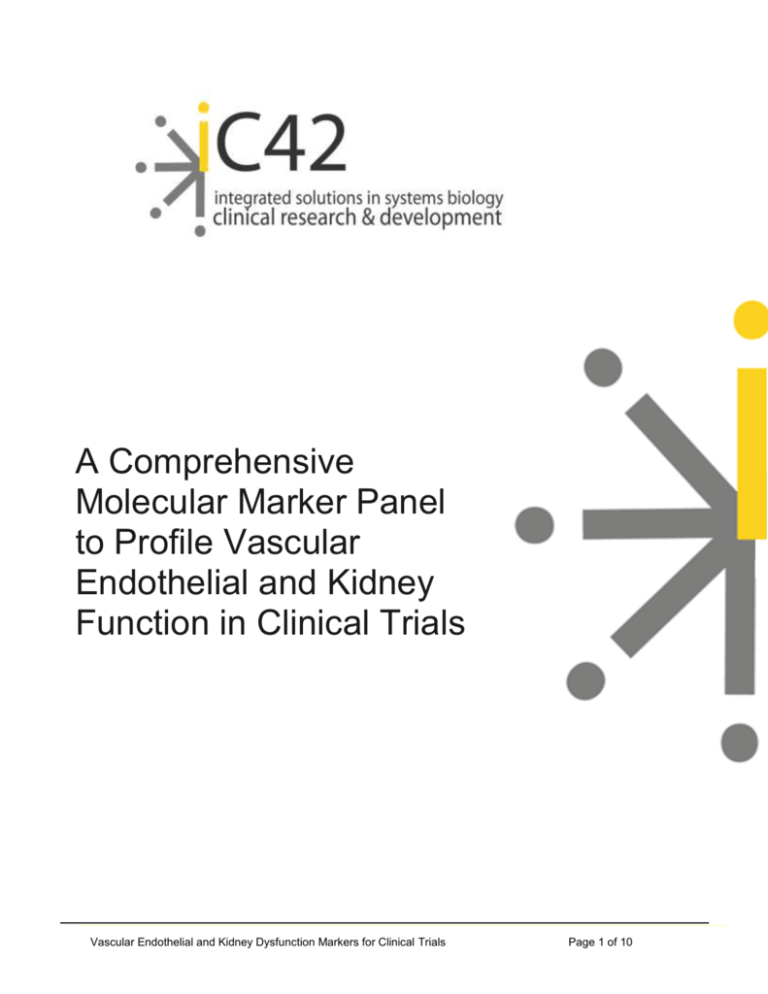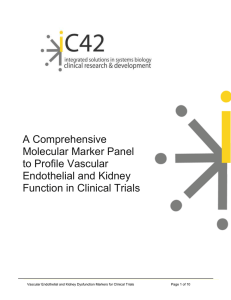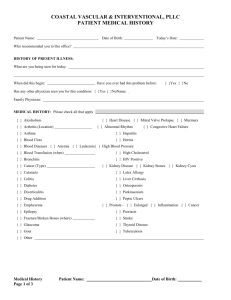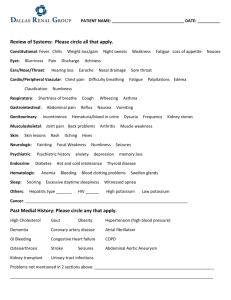About iC42 Clinical Research & Development
advertisement

A Comprehensive Molecular Marker Panel to Profile Vascular Endothelial and Kidney Function in Clinical Trials Vascular Endothelial and Kidney Dysfunction Markers for Clinical Trials Page 1 of 10 About iC42 Clinical Research & Development iC42 Clinical Research & Development provides integrated solutions to systems biology. iC42 is mainly a cutting-edge mass spectrometry laboratory. Our staff is a unique and complementary blend of highly successful academic researchers and bioanalytical specialists with decades of industry experience. We serve as a regulatory compliant laboratory under the umbrella of one of the leading Medical Schools in the United States, the University of Colorado Denver. This collaboration gives us full and instant access to its resources and expertise. Our scientists, who are highly qualified with strong academic track records and extensive industry experience, facilitate innovative projects and strategize developments that are far beyond the capabilities of most established Commercial Research Organizations. Thus, it is not surprising that iC42 Clinical Research & Development has developed into a global resource for “high-end’ bioanalytics that currently collaborates with more than 40 entities including academic groups, clinical networks, biotech and pharmaceutical companies all over the world. Our unique facility is located at the Fitzsimons Bioscience Park and our services include: · Highly Sensitive LC-MS/MS Bioanalytics · Quantification of endogenous compounds and multiplexing technologies (metabolomics, · · · · · · · · proteomics) Molecular Marker Discovery, Qualification & Development Complex Assay Development & Validation GLP Compliant, CAP Accredited, CLIA Certified Quantification of Drugs & Metabolites Isolation of Drug Metabolites & Structural ID Clinical Therapeutic Drug Monitoring Complete PK/PD Package Managed Under One Roof Consulting & Strategic Research Partnership Address for correspondence Uwe Christians, MD, PhD iC42 Integrated Solutions in Systems Biology for Clinical Research and Development Bioscience East, Suite 100 1999 North Fitzsimons Parkway Aurora, CO 80045-7503, USA Phone: +1 303 724 5665 Fax: +1 303 724 5662 e-mail: uwe.christians@ucdenver.edu Vascular Endothelial and Kidney Dysfunction Markers for Clinical Trials Page 2 of 10 Molecular marker panels for vascular endothelial function profiling: 1. NO Pathway: Asymmetric dimethyl arginine (ADMA), symmetric dimethyl arginine (SDMA), L-arginine, L-citrulline, L-ornithin 2. Homocysteine, S-adenosyl methionine, S-adenosyl homocysteine and cysteine 3. Oxidative Stress Markers: 15-f2t-isoprostane (8-epi PGF2a), glutathione 4. Uric acid 5. Amino acid profiles 6. Bioactive lipids (quantification of 19 compounds including leukotrienes (hydroxy eicosatetraenoic acids or HETEs), hydroxy eicosapentaenoic acids (HEPEs), resolvins, protectins and related hydroxy fatty acids). All assays are LC-MS/MS assays in EDTA plasma In addition, serum levels of soluble intercellular adhesion molecule (ICAM)-1, vascular cell adhesion molecule (VCAM)-1, P-selectin, E-selectin, soluble Fas and Fas ligand will be measured as markers of vascular inflammation. Molecular marker panels for kidney function profiling: 7. Urine metabolite profile (LC-MS/MS): - creatinine (glomerular filtration) - glucose (reabsorption in proximal tubule) - citrate, oxoglutarate, succinate, lactate (tubular cell metabolism) - hippurate (active secretion and kidney amino acylase activity) - trimethyl amine oxide (TMAO) (protects against urea-induced protein precipitation, marker for proximal tubule injury) All concentrations will be normalized based on urine osmolarity. 8. Urinary Protein Kidney Dysfunction Markers (Luminex multiplex) β2-microglobulin, cystatin C, urinary clusterin, urinary trefoil factor 3 and kidney injury molecule-1 (EMEA/ FDA markers) and calbindin, epidermal growth factor, glutathione-Stransferase-alpha (GST-alpha), glutathione-S-transferase Yb1 (GST-Yb1), neutrophil gelatinase-associated lipocalcin (NGAL), osteopontin, tissue inhibitor of metalloproteinase-1 (TIMP-1), and vascular endothelial growth factor (VEGF). The following pages provide more detail and background information. Vascular Endothelial and Kidney Dysfunction Markers for Clinical Trials Page 3 of 10 NO Pathway (LC-MS/MS, EDTA plasma) The NO pathway and its regulation will be profiled using an established and validated LC-MS assay that will quantify the following: ADMA and SDMA, L-arginine, mono-methylarginine, Lornithine and L-citrulline. Arginine is the substrate for the enzyme nitric oxide synthase (NOS) to produce NO and L-citrulline in endothelial cells [1,2]. On the other hand, ADMA is a competitive inhibitor of NOS [3]. 1. Palmer RM, Ashton DS, Moncada S. Vascular endothelial cells synthesize nitric oxide from L-arginine. Nature 1988; 333: 664-666. 2. Leone AM, Palmer RM, Knowles RG, Francis PL, Ashton DS, Moncada S. Constitutive and inducible nitric oxide synthases incorporate molecular oxygen into both nitric oxide and citrulline. J Biol Chem 1991; 266: 23790-23795. 3. Vallance P, Leone A, Calver A, Collier J, Moncada S. Accumulation of an endogenous inhibitor of nitric oxide synthesis in chronic renal failure. Lancet 1992; 339: 572-575. Uric Acid Concentrations (LC-MS/MS, EDTA plasma) Uric acid concentrations in plasma will be quantified using a specific and validated LC-MS/MS assay that is based on the following previously published assays: 4. Kim KM, Henderson GN, Ouyang X, Frye RF, Sautin YY, Feig DI, Johnson RJ. A sensitive and specific liquid chromatography-tandem mass spectrometry method for the determination of intracellular and extracellular uric acid. J Chromatogr B Analyt Technol Biomed Life Sci 2009; 877: 2032-2038. 5. Kim KM, Henderson GN, Frye RF, Galloway CD, Brown NJ, Segal MS, Imaram W, Angerhofer A, Johnson RJ. Simultaneous determination of uric acid metabolites allantoin, 6-aminouracil, and triuret in human urine using liquid chromatography-mass spectrometry. J Chromatogr B Analyt Technol Biomed Life Sci 2009; 877: 65-70. Homocystein, S-Adenosyl Homocystein and S-Adenosyl Methionine (LC-MS/MS, EDTA Plasma) Due to large variation in endogenous homocysteine levels, its application as a molecular marker has sometimes been ambiguous [1,2]. As a result, focus has also shifted towards methylation cycle intermediates, in particular trans-methylation pathway intermediates S-adenosyl methionine (SAM) and S-adenosyl homocysteine (SAH) [1-4]. Methionine sulfur metabolism is thought to occur primarily via the trans-sulfuration pathway which results in the transfer of the sulfur from methionine, an essential amino acid that is primarily metabolized in the liver to serine resulting in the formation of cysteine [5,6]. The first step in methionine metabolism is the formation of S-adenosyl methionine (SAM) in a reaction catalyzed by methionine adenyltransferase (MAT) [6]. Under normal conditions, most of the SAM generated in this process is used in trans-methylation reactions, whereby SAM acts as a universal methyl donor for a large variety of acceptor compounds by conversion into SAH through the trans-methylation pathway [6]. This reaction is catalyzed by S-adenosyl homocysteine hydrolase and is reversible with the equilibrium favoring formation of SAH [5]. Several studies have shown evidence that Vascular Endothelial and Kidney Dysfunction Markers for Clinical Trials Page 4 of 10 elevated concentrations of S-adenosylmethionine (SAM) and S-adenosylhomocysteine (SAH) can be used as sensitive indicators of vascular disease [1]. Moreover, decreases in the SAM/SAH ratio, which is also commonly referred to as “methylation potential” have been observed in patients with end-stage renal failure suggesting a link between disturbed transmethylation reactions, vascular dysfunction and impaired renal function [3,4] 1. Wagner C, Koury MJ. S-Adenosyl homocysteine: a better indicator of vascular disease than homocysteine? Am J Clin Nutr 2007; 86: 1581-1585. 2. Kerins DM, Koury MJ, Capdevila A, Rana S, Wagner C. Plasma S-adenosyl homocysteine is a more sensitive indicator of cardiovascular disease than plasma homocysteine. Am J Clin Nutr 2001; 74: 723-729. 3. Jabs K, Koury MJ, Dupont WD, Wagner C, Relationship between plasma S-adenosyl homocysteine concentration and glomerular filtration rate in children. Metabolism 2006; 55: 252-257. 4. Valli A, Carrero JJ, Qureshi AR, Garibotto G, Barany P, Axelsson J, Lindholm B, Stenvinkel P, Anderstam B, Suliman ME. Elevated serum levels of Sadenosylhomocysteine, but not homocysteine, are associated with cardiovascular disease in stage 5 chronic kidney disease patients. Clin Chim Acta 2008; 395: 106-110. 5. Brosnan JT, Brosnan ME. The sulfur-containing amino acids: an overview. J Nutr 2006; 136: 1636S-1640S. 6. Chiang PK, Gordon RK, Tal J, Zeng GC, Doctor BP, Pardhasaradhi K, McCann PP, SAdenosyl methionine and methylation. Faseb J 1996; 10: 471-480. Oxidative Stress Markers: F2-isoprostanes (LC-MS/MS, EDTA plasma) F2-isoprostanes, stable isomers of prostaglandin F2α, are considered a reliable index of in vivo oxidative stress [1,2]. Of the 64 potential F2-isoprostane isomers [3], the most commonly used marker for oxidative stress is 15-F2t-isoprostane (8-epi PGF2a) [1,2]. Elevated plasma and/or urine concentrations of 15-F2t-isoprostane have been reported, among others, in cardiovascular [4] and pulmonary disease [5], Alzheimer disease [6] and type-2 diabetes [7]. Analytical approaches for the quantification of isoprostanes include immunological methods (enzyme-linked immunoassay (ELISA) and radioimmunoassay) and mass spectrometry-based assays (LC-MS and GC-MS). GC-MS assays require extensive sample preparation, including solid-phase extraction (SPE), thin layer chromatography (TLC), and derivatization reactions to protect the polar groups [8,9]. Commercial immunoassays also require extensive sample purification (SPE/TLC) and are usually susceptible to cross-reactivities since F2-isoprostanes and their metabolites share the 1,3-syn-hydroxycyclopentane ring, which is the major determinant of antigenicity [10]. In a recent study, we compared a specific and highly sensitive LC-MS/MS assay [11] with the three most commonly used ELISA assays [12]. All three ELISA assays measured substantially higher 15-F2t-isoprostane concentrations (2.1- 182.2-fold higher in plasma; 0.4-61.9- fold higher in urine) than LC/LC-MS/MS. The most disturbing result of this study was that the relative concentrations measured with one ELISA did not correspond to the relative concentrations measured with another ELISA. This meant that a sample with high 15-F2t-isoprostane concentrations measured with one ELISA showed low concentrations if measured with another ELISA and vice versa. These results suggested that not only the absolute concentrations measured in studies using different ELISAs cannot be compared, but also that the conclusions Vascular Endothelial and Kidney Dysfunction Markers for Clinical Trials Page 5 of 10 drawn from these studies may have been affected by the type of ELISA used. Modern triple stage quadrupole mass spectrometers allow for robust and sensitive semiautomated high-throughput analysis of isoprostanes in plasma and urine [11,12]. Given the overestimation of 15-F2t-isoprostane concentrations especially in plasma as well as the inconsistencies of the results obtained with different ELISAs, LC-MS/MS assays is the method of choice. 1. Roberts LJ, Morrow JD. Measurement of F(2)-isoprostanes as an index of oxidative stress in vivo. Free Radic Biol Med 2000;28:505-13. 2. Morrow JD, Hill KE, Burk RF, Nammour TM, Badr KF, Roberts LJ, 2nd. A series of prostaglandin F2-like compounds are produced in vivo in humans by a noncyclooxygenase, free radical-catalyzed mechanism. Proc Natl Acad Sci U S A 1990;87:9383-7. 3. Morrow JD, Harris TM, Roberts LJ, 2nd. Noncyclooxygenase oxidative formation of a series of novel prostaglandins: analytical ramifications for measurement of eicosanoids. Anal Biochem 1990;184:1-10. 4. Schwedhelm E, Boger RH. Application of gas chromatography-mass spectrometry for analysis of isoprostanes: their role in cardiovascular disease. Clin Chem Lab Med 2003;41:1552-61. 5. Morrow JD, Roberts LJ. The isoprostanes: their role as an index of oxidant stress status in human pulmonary disease. Am J Respir Crit Care Med 2002;166:S25-30. 6. Greco A, Minghetti L, Levi G. Isoprostanes, novel markers of oxidative injury, help understanding the pathogenesis of neurodegenerative diseases. Neurochem Res 2000;25:1357-64. 7. Devaraj S, Hirany SV, Burk RF, Jialal I. Divergence between LDL oxidative susceptibility and urinary F(2)-isoprostanes as measures of oxidative stress in type 2 diabetes. Clin Chem 2001;47:1974-9. 8. Lawson JA, Rokach J, FitzGerald GA. Isoprostanes: formation, analysis and use as indices of lipid peroxidation in vivo. J Biol Chem 1999;274:24441-4. 9. Winnik WM, Kitchin KT. Measurement of oxidative stress parameters using liquid chromatography-tandem mass spectroscopy (LC-MS/MS). Toxicol Appl Pharmacol 2008;233:100-6. 10. Il'yasova D, Morrow JD, Ivanova A, Wagenknecht LE. Epidemiological marker for oxidant status: comparison of the ELISA and the gas chromatography/mass spectrometry assay for urine 2,3-dinor-5,6-dihydro-15-F2t-isoprostane. Ann Epidemiol 2004;14:793-7. 11. Haschke M, Zhang YL, Kahle C, Klawitter J, Korecka M, Shaw LM, Christians U. HPLCatmospheric pressure chemical ionization MS/MS for quantification of 15-F2tisoprostane in human urine and plasma. Clin Chem 2007; 53: 489-97. 12. Klawitter J, Haschke M, Shokati T, Klawitter J, Christians U. Quantification of 15-F2tisoprostane in human plasma and urine: ELISA and LC-MS/MS results cannot be compared. Rapid Commun Mass Spectrom 2011; 25: 463-468. Vascular Endothelial and Kidney Dysfunction Markers for Clinical Trials Page 6 of 10 Amino Acid Profiling (LC-MS/MS, EDTA plasma) The amino acid profile includes the following: 1-methyl-histidine, 2,4-diaminobutyric acid, 3-hydroxy-tyrosine, 3-methyl-histidine, 4aminobenzoic acid, 4-Aminobutyric acid, 4-hydroxyproline, adrenaline, alanine, alanylalanine (dipeptide), allo-isoleucine, aminopimelic acid, anserine, arginine, argininosuccinic acid, asparagine, aspartame acid, aspartame, aspartic acid, carboxymethylcysteine, carnosine, citrulline, cystathionine, cysteine, cysteine-homocysteine (dipeptide), cystine, dimethylarginine (asymmetric), dimethylarginine (symmetric), dopamine, ethanolamine, ethionine, glutamic acid, glutamine, glycine, glycine-proline (dipeptide), histamine, histidine, homoarginine, homocysteine, homocysteine, homophenylalanine, homoserine, isoleucine, leucine, lysine, lysine-alanine (dipeptide), lysinoalanine, methionine sulfone, methionine sulfoxide, methionine sulfoximine, methionine, methionine-d3 (internal standard), norleucine, ornithine, phenylalanine, pipecolic acid, praline, proline-hydroxyproline (dipeptide), pyroglutamic acid, sarcosine, seleno-cystine, seleno-methionine, serine, S-pyridylethyl-cysteine, theanine, thiaproline, threonine, tryptophan, tyrosine, valine, α-aminoadipic acid, α-aminobutyric acid, βalanine, β-aminobutyric acid, β-aminoisobutyric acid, γ-glutamyl-ε-lysine (dipeptide), and δ-hydroxylysine. Bioactive Lipids (LC-MS/MS, EDTA plasma) Simultaneous lipidomic analysis of leukotrienes, resolvins, protectins and related hydroxy fatty acids by LC-MS. Polyunsaturated fatty acids (PUFA) exhibit a range of biological effects many of which are mediated through the production of lipid mediators. Such metabolites are formed through the action of cyclooxygenases (COX), lipoxygenases (LOX), cytochrome P450 monooxygenases (CYP450) or free radical oxidation mechanisms. Arachidonic acid (AA) (20:4n-6) is the precursor of many eicosanoids, a family of potent mediators of the inflammatory response. COX and LOX activities generate series-2 prostanoids, series-4 leukotrienes and hydroxy eicosatetraenoic acids (HETE), whilst CYP450 and autoxidation reactions result in various hydroxy-, hydroperoxy- and epoxy-fatty acids, and F2-isoprostanes. Eicosapentaenoic (EPA) (20:5n-3) and docosahexaenoic (DHA) (22:6n-3) acids are n-3PUFA major constituents of fishoil. EPA-derived mediators include series-3 prostanoids, series-5 leukotrienes, hydroxy eicosapentaenoic acids (HEPE), and F3-isoprostanes. Enzymatic oxidation or auto-oxidation of DHA produces hydroxydocosa hexaenoic acids (HDHA) and neuroprostanes. Recently, it has been shown that EPA and DHA give rise to novel di- and trihydroxy-containing mediators with anti-inflammatory and protective activities termed resolvins (RvE from EPA; RvD from DHA) and protectins (PD from DHA). Finally, LOX metabolism of linoleic acid (LA) results in hydroxy octadecadienoic acids (HODE).Those lipid mediators carry potent bioactivities functioning in a wide range of biological systems including the cardiovascular system, brain, eye, kidney, lungs and skin, and have been investigated for biomarker discovery and drug development. Specific examples include the role of CYP450 metabolites in the regulation of the vascular tone, 8-12HETE and 13-HODE in cutaneous biology, 7-12-LOX products in hippocampal long-term potentiation and long-term depression, corneal injury and angiogenesis, 11-HETE, HODE and HDHA as markers of lipid peroxidation, and, finally, the anti-inflammatory and cellular protective activities of RvE1, RvD1 and PD1.4. The targeted LC-MS/MS assay for 19 bioactive lipids is a modification of the assay described by Masoodi et al. [1] and includes the following: Vascular Endothelial and Kidney Dysfunction Markers for Clinical Trials Page 7 of 10 Pro-inflammatory, hyper-proliferation Several functions Do en cos oi ah c ac exa id - Ei c en osa oi pe c ac nta id - ch ac ido id nic Ar a Li no ac lei id c Several functions Anti-inflammatory, protective 1. Masoodi M, Nicolaou A. Lipidomic analysis of twenty-seven prostanoids and isoprostanes by liquid chromatography/electrospray tandem mass spectrometry. Rapid Commun Mass Spectrom 2006;20:3023-9. Molecular marker panels for kidney function profiling (urine) Early proximal tubule dysfunction will be assessed using two sets of markers: urinary metabolite and urinary protein dysfunction markers. Based on our previous work studying the molecular mechanisms of CNI toxicity, we have identified the following combinatorial metabolite markers [1,2]. Our laboratory quantifies these markers simultaneously in the same run using a validated LC-MS/MS assay: - creatinine (glomerular filtration) - glucose (reabsorption in proximal tubule) - citrate, oxoglutarate, succinate, lactate (tubular cell metabolism) - hippurate (active secretion and kidney amino acylase activity) - trimethyl amine oxide (TMAO) (protects against urea-induced protein precipitation) Based on genomic screening, several proteins have been identified as indicators of kidney damage and tubular repair [EMEA Doc. Ref. EMEA/250885/2008/Rev. 1, [3]. This includes kidney injury molecule-1 (KIM-1), urinary clusterin, trefoil factor 3 and interleukin 18, to name a few. The US FDA and the European EMEA approval of a set of seven protein kidney dysfunction markers for use in pre-clinical rat toxicity studies can be considered a milestone (for more details, please see EMEA document EMEA/250885/2008/Rev. 1, Final Report on the Joint EMEA/FDA VXDS Experience on Quantification of Nephrotoxicity Biomarkers, the complete May 2010 issue of Nature Biotechnology and [4]. The measurement will be carried out using a commercial Luminex array kit. This kit includes: β2-microglobulin, cystatin C, urinary clusterin, urinary trefoil factor 3 and kidney injury molecule-1 (EMEA/ FDA markers) and calbindin, epidermal growth factor, glutathione-S-transferase-alpha (GST-alpha), glutathione-S-transferase Yb1 (GST-Yb1), neutrophil gelatinase-associated lipocalcin Vascular Endothelial and Kidney Dysfunction Markers for Clinical Trials Page 8 of 10 (NGAL), osteopontin, tissue inhibitor of metalloproteinase-1 (TIMP-1), and vascular endothelial growth factor (VEGF). These markers not only allow for sensitive monitoring of kidney function and injury but also convey information about the location of kidney injury and its mechanism (please see Figure 1 below). From Christians U, et al. The role of proteomics in the study of kidney diseases and in the development of diagnostic tools. In: Biomarkers of Kidney Disease. Edelstein C (ed.) Elsevier, San Diego (2010) Figure 1. Protein Markers of Kidney Injury and Their Mapping to the Nephron. 1. Klawitter J, Klawitter J, Kushner E, Jonscher KR, Bendrick-Peart J, Leibfritz D, Christians U, Schmitz V. Association of immunosuppressant-induced protein changes in the rat kidney with changes in urine metabolite patterns: A proteo-metabonomic study. J Proteome Res 2010; 9: 865-875. Vascular Endothelial and Kidney Dysfunction Markers for Clinical Trials Page 9 of 10 2. Klawitter J, Bendrick-Peart J, Rudolph B, Beckey V, Klawitter J, Haschke M, Rivard C, Chan L, Leibfritz D, Christians U, Schmitz V. Urine metabolites reflect time-dependent effects of cyclosporine and sirolimus on rat kidney function. Chem Res Toxicol 2009; 22: 118-128. 3. Christians U, Klawitter J, Klawitter J, Brunner N, Schmitz V. Biomarkers of immunosuppressant organ toxicity after transplantation- status, concepts and misconceptions. Expert Opin Drug Metabol Toxicol 2011; 7:175-200 4. Coca SG, Yalavarthy R, Concato J, Parikh CR. Biomarkers for the diagnosis and risk stratification of acute kidney injury: a systematic review. Kidney Int 2008; 73: 1008-1016. Vascular Endothelial and Kidney Dysfunction Markers for Clinical Trials Page 10 of 10









